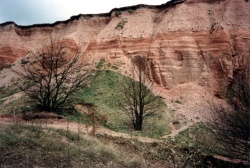Barr Beacon
Barr Beacon and the surrounding area were shaped by glacial and subsequent processes of erosion at the end of the Ice-age but it’s the rocks forming the ridge that make it such a distinctive landscape feature. The rocks were deposited in the deserts of early Triassic age, 241 – 248 million years ago. Two distinct rock units are present. The lower, older unit is a sandstone with thin beds of quartzite breccia known as the Hopwas Breccia which now can only be seen in the quarry. This southern end of the ridge has been affected by an east-west fracture known as the Barr Beacon Fault which has the effect of a westward displacement so that the quarry is about 100 metres west of the main ridge. Overlying the breccia and forming the hard protective capping to the ridge is the Kidderminster Formation comprising a thick pebble conglomerate with thinner impersistent sandstones. Nearby there is also some evidence of sands and gravels and other features from the Ice-age.




